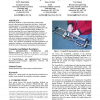338 search results - page 67 / 68 » Adapting Human Motion for the Control of a Humanoid Robot |
IROS
2008
IEEE
13 years 11 months ago
2008
IEEE
— This paper presents a beat-counting robot that can count musical beats aloud, i.e., speak “one, two, three, four, one, two, ...” along music, while listening to music by us...
ICANN
2005
Springer
13 years 10 months ago
2005
Springer
The HYDRA work provides insight into the exploitation of holistic behavioural and morphological adaptation in the design of new artefacts. The potential of the new design principle...
GECCO
2007
Springer
13 years 9 months ago
2007
Springer
A primary goal of evolutionary robotics is to create systems that are as robust and adaptive as the human body. Moving toward this goal often involves training control systems tha...
ACIVS
2007
Springer
13 years 11 months ago
2007
Springer
This paper presents a monocular vision framework enabling feature-oriented appearance-based navigation in large outdoor environments containing other moving objects. The framework ...
ICMI
2003
Springer
13 years 10 months ago
2003
Springer
Kinesthetic feedback is a key mechanism by which people perceive object properties during their daily tasks – particularly inertial properties. For example, transporting a glass...

